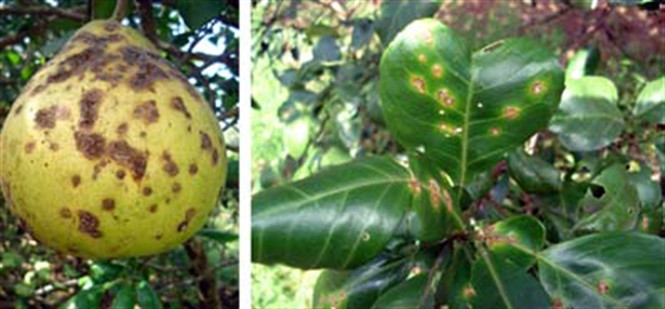Citrus canker disease and prevention measures
Canker disease damages fruit trees, often causing fruit and leaves to fall, leaving the tree stunted and quickly withered.
Canker disease damages fruit trees, often causing fruit and leaves to fall off, making the trees stunted and quickly withered. In nurseries, when the disease is severe, seedlings easily die, and diseased fruit has poor quality and cannot be exported or stored. In our country, this disease is common in all citrus growing areas, causing significant damage to growers and greatly affecting export products.
 |
| Symptoms of the disease on fruit and leaves |
1. Symptoms of the disease
In young leaves, the initial symptoms of the disease are small spots with a diameter of about 1mm, clear yellow in color, often seen on the underside of the leaf, then the diseased spots expand and break the epidermis of the underside of the leaf, pale white or light brown in color. The diseased leaves do not change shape but fall off easily, severely infected seedlings often lose their leaves.
The lesions on the fruit are similar to those on the leaves: the lesions are rougher and browner, with raised edges and cracked dead tissue in the middle. The entire thickness of the fruit skin may be ulcerated, but the ulcers do not penetrate deep into the fruit. Severe disease can cause the fruit to become deformed, have little water, dry out early, and fall off easily.
The disease causes the fruit to look bad and not meet the quality standards for export. The lesions on the branches and trunks of young trees are similar to those on the leaves but are raised and relatively clear. In particular, there are cases where the ulcers on the trunk are up to 15 cm long and on the branches up to 5 - 7 cm.
2. Causes
Caused by Xanthomomas campestris pv. citri (Hasse) Dye. Rod-shaped bacteria, one end has a flagellum, gram-negative, aerobic. Colonies on culture medium are shiny yellow, slightly pink, with slightly wavy edges.
3. Transmission method
The bacteria that cause the disease survive on the remains of leaves, fruits, stems, and branches of diseased trees. The bacteria spread by mechanical agents, wind, and rainwater. Therefore, the disease often causes serious damage in humid weather conditions, during the rainy season.
4. Characteristics of occurrence
Canker disease occurs all year round, but is more severe in the rainy season than in the dry season. The disease occurs and develops strongly in conditions of high humidity and temperatures of 26 - 35 degrees Celsius. Canker disease spreads very quickly. The disease affects all citrus varieties. Lemons and grapefruits are most severely affected. The Xa Doai orange, Van Du orange, and Song Con orange varieties are more severely affected than the lemon orange and mandarin orange varieties.
The disease starts from spring buds (March), increases sharply to summer buds (July and August) and then to winter buds (October and November) when the disease gradually decreases and stops developing. The younger the tree, the more susceptible it is to serious disease, especially in nurseries where grafted seedlings often get seriously ill in the first 1-2 years, while oranges from 5-6 years old have a lower rate of disease. Branches that develop many buds are often more seriously ill, and orange varieties are very susceptible to disease 30-45 days after buds appear.
When the shoots are stable but not yet old, the susceptibility to disease is highest. After the flowers fall, the young fruit begins to be infected. When the fruit stops growing and begins to yellow, it is almost no longer infected. In addition, leafhoppers are also disease vectors, creating wounds for the disease to easily penetrate, especially in the nursery.
5. Prevention measures
- Fruit gardens need a good drainage system, do not plant diseased seedlings and do not plant too densely to create ventilation for the garden. Cut and collect diseased branches, leaves and fruits to destroy the source of the disease. In diseased gardens, do not water the canopy in the cool afternoon, do not overwater. Periodically prune the canopy to prevent the garden from becoming dense. Avoid creating mechanical wounds for bacteria to enter.
- Balanced NPK fertilizer. Increase potassium fertilizer for diseased gardens. Do not apply nitrogen fertilizer or foliar fertilizer when the disease is developing and causing damage.
- Prevent leaf miner with SK Enspray 99EC mineral oil and chemicals.
- Spray to prevent when the new shoots appear or when the disease begins to appear. When the disease is severe, spray 2-4 times, each time 10-15 days apart. Use copper-based pesticides such as Bordeaux 1%, Kasuran 0.15%, champion 37.5FL, Bordeaux + zineb, Copper oxychloride... spray when the tree has new shoots, the amount of water sprayed is 600-800 liters/ha.
According to Nongnghiep.vn






